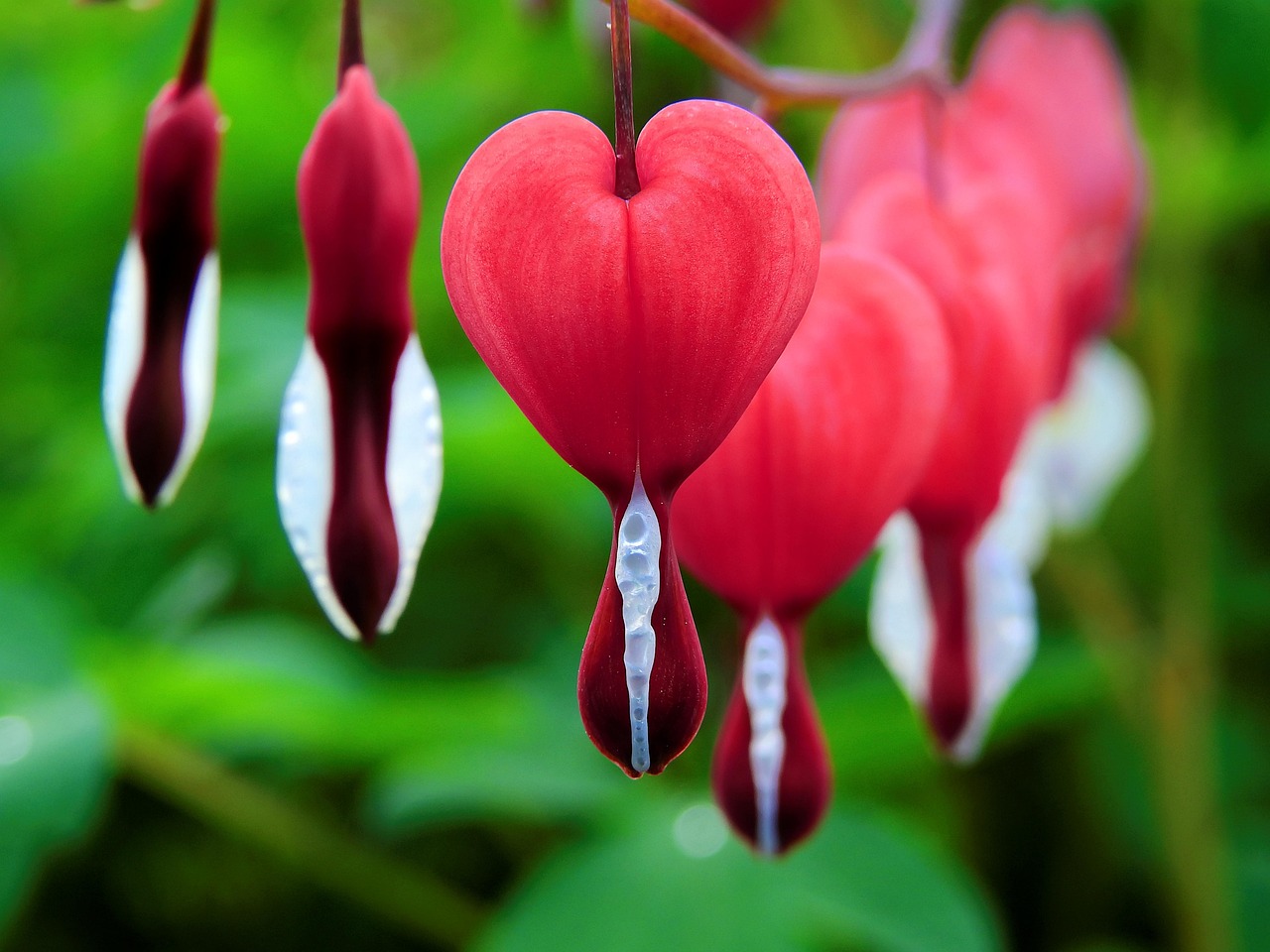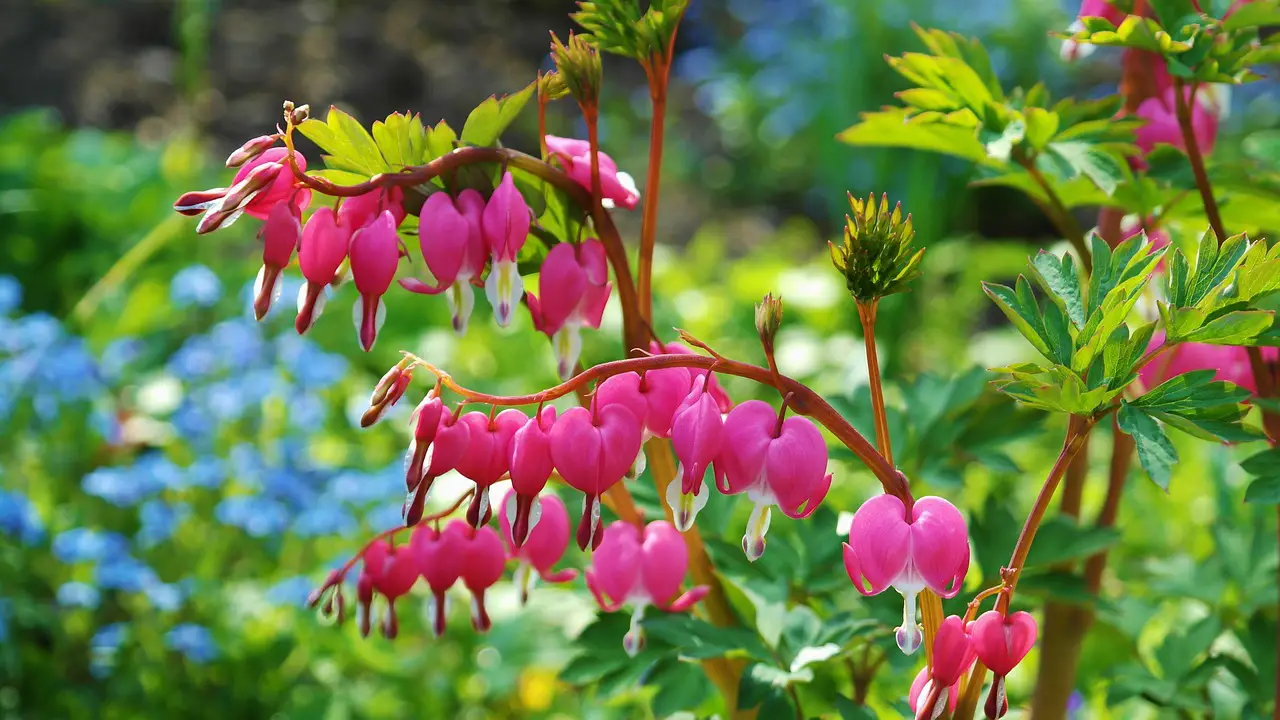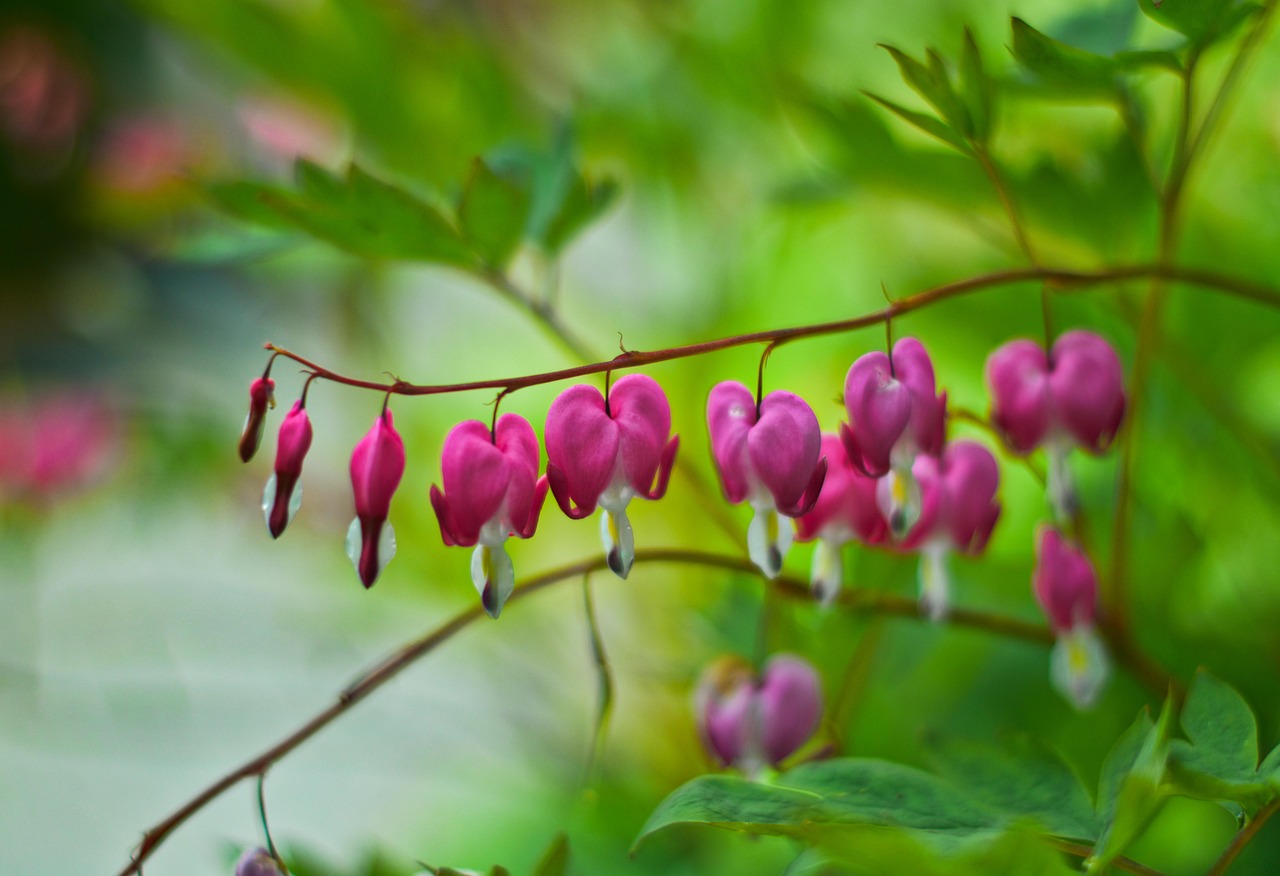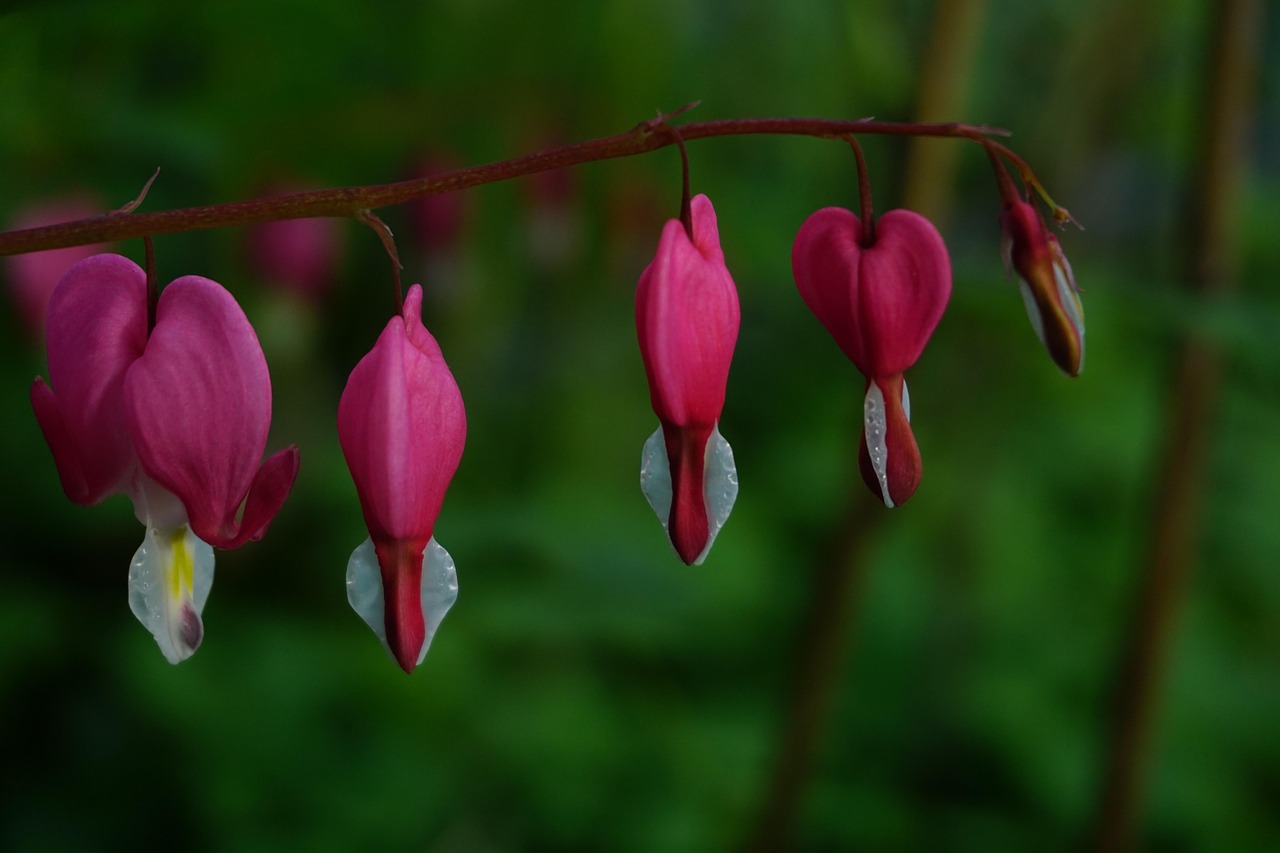The Bleeding Heart plant is a stunning perennial known for its heart-shaped flowers. To grow beautiful blooms, provide partial shade, well-drained soil, and consistent moisture. Regularly deadhead spent flowers and divide the plants every few years to maintain health and vigor.
Bleeding Heart plants, scientifically known as Dicentra spectabilis, are cherished in gardens for their unique and graceful appearance. These plants flourish in temperate regions and are often among the first to bloom in spring, providing color and interest when many other plants are still waking from winter dormancy. Their delicate, heart-shaped flowers dangle from arching stems, creating a whimsical effect that captivates garden enthusiasts.

Native to Asia, the Bleeding Heart plant has been cultivated for centuries. It has become a favorite for shaded garden spots, making it an excellent choice for woodland gardens or areas with filtered sunlight. Understanding how to care for these plants is essential for anyone looking to add this beauty to their landscape.
Understanding Bleeding Heart Plants
Bleeding Heart plants are not just beautiful; they also have specific requirements that must be met for optimal growth. Here are some key characteristics and needs of this plant:
- Light Requirements: Prefer partial to full shade. Too much direct sunlight can scorch their leaves.
- Soil Type: Thrive in rich, well-drained soil with plenty of organic matter.
- Watering: Require consistent moisture, particularly during dry spells. However, avoid waterlogging the roots.
- Temperature: Best suited for cooler climates. They may struggle in extreme heat.
Another interesting aspect of the Bleeding Heart is its life cycle. Typically, these plants will bloom from late spring until early summer. After flowering, the foliage may die back in the summer, which is a normal part of their life cycle. This dormancy allows the plant to conserve energy until the following spring.

Planting Bleeding Heart
When planting Bleeding Heart, timing and location are crucial. Here are steps to ensure successful planting:
- Select a Location: Choose a spot with partial shade, ideally under deciduous trees where they will receive dappled sunlight.
- Prepare the Soil: Amend the soil with compost or well-rotted manure to enhance fertility and drainage.
- Planting Depth: Dig a hole about 12 inches deep and wide. Place the plant at the same depth it was in its pot.
- Watering: Water thoroughly after planting to help establish roots.
It is best to plant these perennials in early spring or fall. This allows them to establish roots before the harsh conditions of summer or winter set in.
Caring for Bleeding Heart Plants
Caring for Bleeding Hearts involves several important tasks to keep them healthy and thriving throughout their lifecycle. Regular maintenance will ensure vibrant blooms and strong foliage:

- Watering: Ensure consistent moisture but avoid soggy soil. Water deeply during dry spells.
- Fertilizing: Use a balanced fertilizer in early spring as new growth begins. This supports vigorous blooming.
- Pruning: Deadhead spent flowers to encourage more blooms and tidy the plant’s appearance.
- Dividing: Every 3-4 years, divide the plant to prevent overcrowding and promote healthy growth.
By providing proper care, Bleeding Heart plants can thrive for many years in your garden. With their enchanting flowers and lacy foliage, they can transform any shaded area into a picturesque retreat.
| Care Aspect | Recommendation |
|---|---|
| Light | Partial to full shade |
| Soil | Rich, well-drained |
| Watering | Consistent moisture |
| Fertilizing | Balanced fertilizer in spring |
The Bleeding Heart plant is a delightful addition to any garden. With the right care, it can reward you with stunning flowers that bring joy year after year.
Pests and Diseases Affecting Bleeding Heart Plants
While Bleeding Heart plants are generally hardy, they can be susceptible to certain pests and diseases. Recognizing these issues early is crucial to maintaining the health of your plants. Below are common pests and diseases that can affect Bleeding Heart plants:

- Aphids: These small, soft-bodied insects can cluster on young shoots and buds. They suck sap, leading to distorted growth.
- Slugs and Snails: These pests may chew on leaves, creating holes and leaving a slimy trail behind.
- Powdery Mildew: A fungal disease characterized by a white, powdery coating on leaves, often caused by high humidity and poor air circulation.
- Botrytis Blight: This fungal infection can cause brown spots on leaves and flowers. It thrives in cool, moist conditions.
To combat these issues, implement the following strategies:
Pest Management Techniques
- Regular Monitoring: Frequently check your plants for signs of pests or disease. Early detection is key.
- Insecticidal Soap: Apply insecticidal soap or neem oil to control aphids and other soft-bodied insects.
- Handpicking: For slugs and snails, handpicking can be effective in reducing their numbers.
- Improve Air Circulation: Ensure adequate spacing between plants to promote airflow and reduce humidity, which helps prevent fungal diseases.
If you notice signs of disease despite your best efforts, consider removing affected plant parts. This will help prevent the spread of the issue.
Propagation of Bleeding Heart Plants
Propagating Bleeding Heart plants can be a rewarding experience. There are two primary methods: division and seed propagation. Here’s how you can successfully propagate your Bleeding Hearts.
1. Division
The most common method of propagation is division, which is best done in early spring or fall when the plant is not actively blooming. Follow these steps:
- Choose Healthy Plants: Select mature plants that are at least three years old for division.
- Dig Up the Plant: Carefully lift the plant from the ground using a spade or garden fork.
- Divide the Roots: Gently separate the root ball into smaller sections, ensuring that each section has roots and some foliage.
- Replant: Plant each new section in prepared soil, following the same care guidelines as established plants.
2. Seed Propagation
While seed propagation can be more challenging, it is another option for those interested in growing new plants from scratch. Here’s how to do it:
- Collect Seeds: After flowering, allow the seed pods to mature on the plant before harvesting.
- Prepare for Sowing: Sow seeds in a sterile seed-starting mix. Lightly cover them with soil.
- Provide Moisture: Keep the soil consistently moist but not soggy. Covering with plastic wrap can help retain moisture.
- Transplant Seedlings: Once seedlings have grown several sets of leaves, transplant them into individual pots or directly into the garden.
Seasonal Care for Bleeding Heart Plants
Caring for Bleeding Heart plants involves adapting your approach based on the seasons. Each season presents unique challenges and opportunities for enhancing plant health.
Spring Care
- Fertilization: Apply a balanced fertilizer as new growth appears to promote healthy blooms.
- Weeding: Remove any weeds that may compete for nutrients and water.
- Irrigation: Ensure consistent moisture as the plant begins its growth cycle.
Summer Care
- Watering Needs: Increase watering during hot spells but avoid over-watering. Maintain soil moisture without waterlogging.
- Pest Monitoring: Keep an eye out for pests and take action if necessary.
- Dormancy Awareness: Be prepared for foliage to die back in late summer as the plant enters dormancy.
Fall Care
- Cutting Back: After the foliage dies back, cut stems down to ground level to prepare for winter.
- Mulching: Apply a layer of mulch around the base of the plant to insulate roots during colder months.
winter Care
- Avoid Overwatering: Ensure that the soil does not remain overly wet during winter to prevent root rot.
- Protection: In regions with harsh winters, consider adding extra mulch or protective coverings to safeguard against frost damage.
By understanding seasonal care requirements, you can ensure the health and beauty of your Bleeding Heart plants year-round.
Common Varieties of Bleeding Heart Plants
Bleeding Heart plants come in several varieties, each with unique characteristics and beauty. Understanding these different types can help you select the best one for your garden. Below are some popular varieties:
- Dicentra spectabilis: The classic variety, known for its pink heart-shaped flowers that bloom in spring. It typically grows 2 to 3 feet tall.
- Dicentra eximia: Also called the Fringed Bleeding Heart, this variety features more delicate, fern-like foliage and produces yellowish-pink flowers. It is hardy and blooms longer than the standard variety.
- Dicentra formosa: Known as the Pacific Bleeding Heart, it has smaller flowers and is native to the western United States. It thrives in shady areas and typically grows 1 to 2 feet tall.
- Dicentra ‘Luxuriant’: This hybrid offers lush, green foliage and bright pink flowers. It is known for its vigorous growth and disease resistance.
When selecting a variety, consider factors like your garden’s climate, soil type, and desired height. Each type has its unique charm, making it easy to find one that fits your aesthetic preferences.
Designing with Bleeding Heart Plants
Incorporating Bleeding Heart plants into your garden design can create stunning visual interest. Their unique flowers and foliage make them versatile companions for various other plants. Here are some tips for designing with Bleeding Hearts:
Companion Planting
Choose companion plants that complement the Bleeding Heart’s beauty while sharing similar care requirements. Consider these options:
- Hostas: These shade-loving perennials have lush foliage that pairs well with the delicate flowers of Bleeding Hearts.
- Ferns: Their airy texture contrasts nicely with the heart-shaped leaves of Bleeding Hearts, creating a layered look.
- Astilbes: With their feathery plumes of flowers in various colors, Astilbes can provide height and additional color in the garden.
- Brunnera macrophylla: Commonly known as False Forget-Me-Not, this plant adds a charming blue flower that complements the pink of Bleeding Hearts.
Garden Layout Ideas
When planning your garden layout, consider the following arrangements:
- Understory Planting: Plant Bleeding Hearts beneath taller trees or shrubs to provide dappled shade. This arrangement mimics their natural habitat.
- Borders and Edges: Use Bleeding Hearts as a border along pathways or garden edges for a soft, romantic feel.
- Massing Plantings: Group several Bleeding Heart plants together to create a striking display of color and texture during their blooming period.
Bleeding Heart Care FAQs
Caring for Bleeding Heart plants can raise several questions among gardeners. Here are some frequently asked questions and their answers to help you navigate common concerns:
What should I do if my Bleeding Hearts aren’t blooming?
If your Bleeding Hearts are not blooming, consider the following:
- Light Conditions: Ensure they are receiving adequate partial shade, as too much sun can hinder flowering.
- Nutrient Levels: Check if the soil is rich enough in nutrients. A balanced fertilizer may be necessary.
- Aging Plants: If the plants are older than three years, consider dividing them to rejuvenate growth.
Can I grow Bleeding Hearts in containers?
Yes, you can grow Bleeding Hearts in containers. Make sure to use a large pot with good drainage and provide consistent moisture. Choose a location that receives partial shade.
How often should I water my Bleeding Heart plants?
Water regularly to maintain consistent moisture, especially during dry spells. However, ensure the soil does not become waterlogged, as this can lead to root rot.
Are Bleeding Heart plants deer-resistant?
While no plant is entirely deer-proof, Bleeding Hearts are often considered deer-resistant due to their slightly toxic nature. However, hungry deer may still nibble on them if food is scarce.
Nutritional Needs of Bleeding Heart Plants
Providing the right nutrients is essential for healthy growth and vibrant blooms. Here’s a breakdown of the nutritional needs of Bleeding Heart plants:
| Nutrient | Importance | Source |
|---|---|---|
| Nitrogen (N) | Promotes leaf growth and overall plant vigor. | Organic fertilizers, compost. |
| Phosphorus (P) | Encourages flowering and root development. | Bone meal, balanced fertilizers. |
| Potassium (K) | Aids in overall plant health and disease resistance. | Kelp meal, composted manure. |
A balanced fertilizer applied in spring can help meet these nutritional needs and support healthy blooming throughout the growing season.
Additional Tips for Thriving Bleeding Heart Plants
To ensure your Bleeding Heart plants not only survive but thrive, consider these additional tips:
- Monitor Soil pH: Bleeding Hearts prefer slightly acidic to neutral soil (pH 6.0 to 7.0). Test your soil and amend it if necessary to achieve the ideal pH.
- Apply Mulch: A layer of organic mulch helps retain moisture, suppress weeds, and regulate soil temperature, creating a more stable growing environment.
- Consider Companion Plants: As mentioned earlier, planting with companions like Hostas or ferns can enhance the beauty of your garden while providing beneficial shade.
- Observe Seasonal Changes: Keep track of how your Bleeding Hearts respond to seasonal weather changes. This observation can help you adjust care practices accordingly.
By implementing these strategies, you can foster a healthy environment that supports the growth and blooming of Bleeding Heart plants.
Potential Challenges and Solutions
Every gardener faces challenges, and Bleeding Heart plants are no exception. Here are some potential issues and how to address them:
1. Poor Blooming
If your Bleeding Hearts are not blooming as expected, it could be due to inadequate sunlight or nutrient deficiencies. Ensure they receive at least partial shade and consider using a balanced fertilizer to promote blooming.
2. Yellowing Leaves
Yellowing leaves can indicate overwatering or nutrient deficiencies. Check the soil moisture and adjust your watering schedule. Consider adding organic compost to enhance soil nutrition.
3. Fungal Issues
If you notice signs of fungal diseases like powdery mildew, improve air circulation around the plants by spacing them appropriately. Remove affected leaves and avoid overhead watering to minimize humidity around the foliage.
By being proactive in identifying and resolving these challenges, you can maintain the health and beauty of your Bleeding Heart plants.
Caring for Bleeding Hearts in Different Climates
The climate in which you live plays a significant role in how you care for your Bleeding Heart plants. Below are tips for different climates:
Tropical Climates
In tropical regions, Bleeding Hearts may struggle due to high heat and humidity. Ensure they are planted in shaded areas and monitor soil moisture closely. Consider using shade cloth during peak sun hours to protect the plants.
Temperate Climates
Bleeding Hearts thrive in temperate climates with distinct seasons. Follow the seasonal care guidelines mentioned earlier, and be sure to prepare for winter by mulching and protecting the roots against harsh conditions.
Cold Climates
In colder climates, it’s essential to ensure proper drainage to prevent waterlogging during winter months. Use raised beds if necessary and apply a thick layer of mulch for insulation during freezing temperatures.
Final Thoughts
Caring for Bleeding Heart plants can be a rewarding endeavor for any gardener. With their stunning heart-shaped flowers and lush foliage, they add charm and elegance to shaded areas of the garden. By understanding their specific light, water, and soil requirements, you can cultivate a thriving environment for these beautiful plants.
Throughout the seasons, regular monitoring for pests, diseases, and overall plant health is paramount. Knowledge of common varieties allows you to choose the best fit for your landscape, while thoughtful companion planting enhances the beauty of your garden design.
As you embark on your journey with Bleeding Hearts, embrace the learning process that comes with gardening. Each season brings new challenges and opportunities for growth. With patience, dedication, and a little creativity, you can enjoy the delightful blooms of Bleeding Heart plants each spring, creating a lasting impact in your garden.
